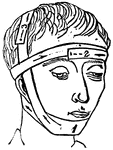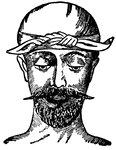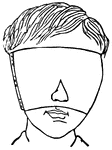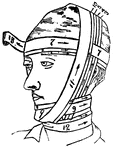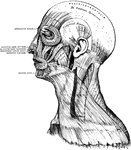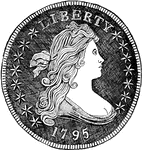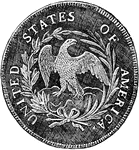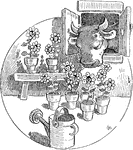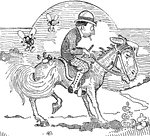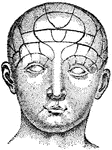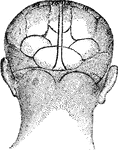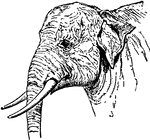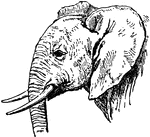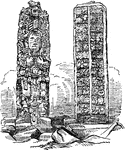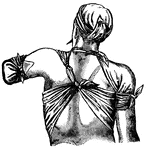
Triangular Bandage
This illustration shows a method of applying a triangular bandage to the chest, shoulder, head and elbow.

Electricity
This illustration shows the field of force between two parallel planes. At the edges its lines of foce…
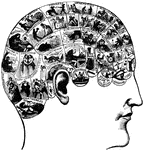
Phrenology
A theory which claims to be able to determine character, personality traits, and criminality on the…
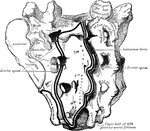
Sacrum
A large, triangular bone at the base of the vertebral column at the upper and back part of the pelvic…
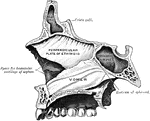
Vomer
The vomer is a single bone, situated vertically at the back part of the nasal fossae, forming part of…
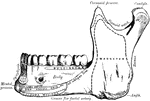
Mandible
The mandible is the largest and strongest bone of the face. It serves for the reception of the lower…

First Rib
The first rib is the shortest and the most curved of all the ribs; it is broad and flat, its surfaces…
Eleventh Rib
The eleventh and twelfth ribs have each a single articular facet on the head, which is of rather large…
Twelfth Rib
The eleventh and twelfth ribs have each a single articular facet on the head, which is of rather large…
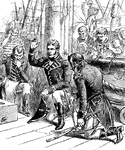
Before Battle Prayer
The crew of a naval ship in the Revolutionary War praying before they head in to battle.

Protoplasm
The circulation of protoplasm (p) in a cell of the stamen-hair of Tradescania. In the channels the granules…

Spermatozoa
"Types of spermatozoa. A, from the round worm (Ascaris) with a cap, somewhat amaeboid; B, from the Crayfish,…

Mosquito Head
"The head of female mosquito (culex). a, antenna; c, clypeus; h, hypopharynx; m, mandibles; ma., maxillas;…

Double Crown
A gold coin of the value of 10 or 11 shillings, current in England in the seventeenth century. It was…

Dragonfly
They have a long slender body, large head with enormous eyes, very strong jaws, and two pairs of large…

Vulturine Pie
A bird around 16 inches in length with a 7 inch tail. The head is bald and a bright yellow color. The…

Pike Perch
A fish with elongated form, subconical head, and sharp canines mixed with the villiform teeth from the…

Pilchard
A fish resembling the herring, but thicker and rounder, with the under jaw shorter, the back more elevated,…

Pillory
A frame of wood erected on a post or pole, with movable boards resembling those in the stocks, and the…
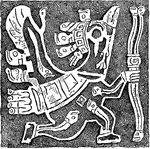
Bas-Relief
Winged human figure with the crowned head of a condor, from the central row on the monolithic doorway.…
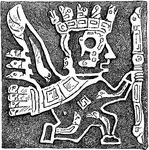
Bas-Relief
A winged human figure with human head crowned, from the upper row on the monolithic doorway. Details…

Pinner
A woman's head dress, having long flaps hanging down the sides of the cheeks, worn during the early…

Surinam Toad
Its color is brownish olive, above and whitish below. It is sometimes 7 inches long, and has a peculiarly…

Swallowing Muscles
"The circular muscle of the mouth (1) and the buccinator or trumpeter's muscle (2) help the tongue to…
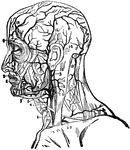
Facial Arteries
"1, primitive carotid artery dividing itself into carotid external and carotid internal; 3, occipital…
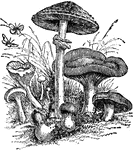
Mushroom
"The name of several classes of fungi. The best known is the common mushroom. It has a fleshy head,…
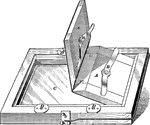
Painting Frame
"A printing frame that is well adapted to sheets not over 17 in. x 21 in. The frame is placed face downwards…
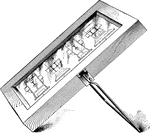
Painting Frame
"A printing frame that is well adapted to sheets not over 17 in. x 21 in. The frame is placed face downwards…

Great Black Backed Gull
"A long-winged water-bird with webbed feet, inhabiting all parts of the world. The group to which gulls…

Black-headed Gull
"A long-winged water-bird with webbed feet, inhabiting all parts of the world. The group to which gulls…
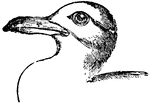
Killiwake Gull
"A long-winged water-bird with webbed feet, inhabiting all parts of the world. The group to which gulls…
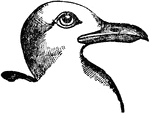
Small Black-Backed Gull
"A long-winged water-bird with webbed feet, inhabiting all parts of the world. The group to which gulls…

Herring Gull
"A long-winged water-bird with webbed feet, inhabiting all parts of the world. The group to which gulls…

Boa
"In popular language, the name of all those large serpents which kill their prey by entwining themselves…
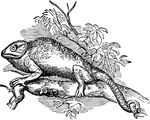
Chameleon
"A genus of saurian reptiles, constituting a distinct family, of very peculiar form and structure, and…
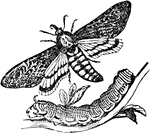
Death's Head Moth
"A species of Hawk-moth or lepidopterous insect of the family Sphingidae, not uncommon in some parts…

Prime
"Prime, Parade. In using prime to parry the thrust in seconde, pass your point over the adversary's…

Magnified Louse
"A genus of insects, the type of a very numerous family, which forms the order Parasita or Auoplura.…
